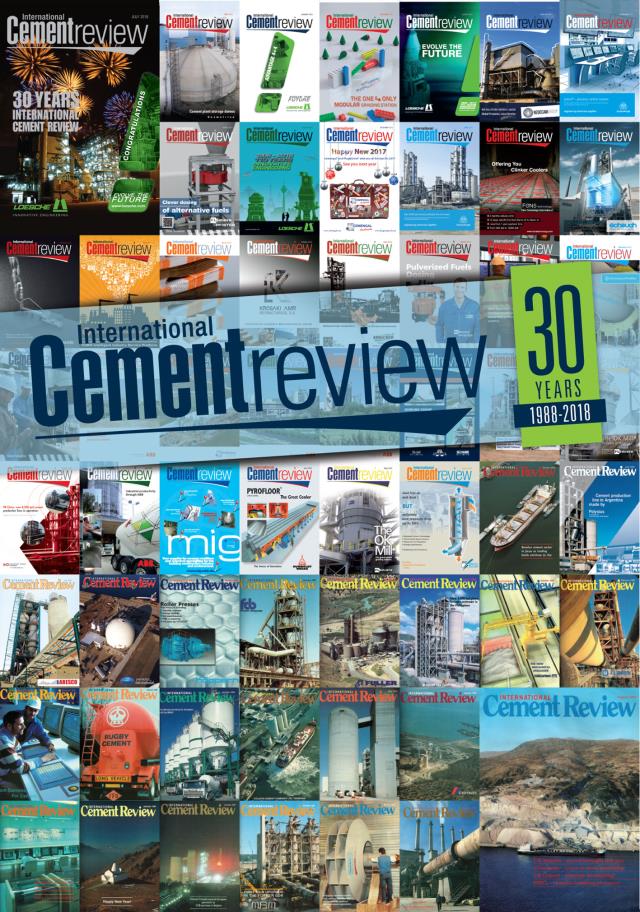International Cement Review celebrates its 30th anniversary this July with a special double issue of the magazine, including exclusive interviews with some of the industry's most influential figures alongside articles on manufacturing excellence and a series of reports on the future of the cement industry to 2050.

30 years of International Cement Review
Industry leaders
In his exclusive interview with ICR, Dr Thomas Schmidheiny, Honorary Chairman of LafargeHolcim, provides a masterclass on how to build a global cement business. He tells the story of how the company grew from its humble origins in Holderbank to become the largest multinational building materials company in the world. Along the way, we hear fascinating insights into Dr Schmidheiny's early career as a plant engineer and how he succeeded in transforming the company in the 1980s and 1990s via numerous acquisitions, culminating in the dramatic merger with Lafarge in 2015.
Meanwhile, Dr Bernd Scheifele, CEO of HeidelbergCement, reflects on the Italcementi acquisition, drivers for the deal, and why he is optimistic for the future. He also warns again the momentum to invest in Africa where there is a need for caution in certain high-risk markets.
30 years of change
A historical perspective of the leading multinational cement producers over the past 30 years is discussed by leading analyst Jean-Christophe Lefèvre-Moulenq. He argues that further mergers and acquisitions will continue to transform the industry, which is now unrecognisable from a decade ago.
Manufacturing excellence
With sustainability now well entrenched in the everyday business of cement plants, Philippe Fonta of the World Business Council for Sustainable Development (WBCSD) reports on the updated 2018 roadmap to set an energy pathway and a CO2 emission trajectory that is consistent with at least a 50 per cent chance of limiting the average global temperature increase of 2°C by 2100.
Dr Martin Schnieder, VDZ, looks at manufacturing excellence and where the industry should go to find the next level of improvements – energy efficiency, alternative fuels, reduced clinker factor, carbon capture and a digitised cement industry.
Setting the highest standards for energy efficiency in the industry are the cement producers in India and Ashutosh Saxena, National Council for Cement and Building Materials, sets out how the world's second largest cement industry will cope with cement demand rising to 550Mta by 2025.
Manufacturing excellence is already heralded as the day-to-day standard at Votarantim's Vidal Ramos plant in Brazil, where performance indicators and sustainable practices make it a top-rated plant.
The search for better alternatives to ordinary Portland cement has lead EPFL and Cementis Consulting to further develop the use of calcined clay elements as a high-performance and cost-effective alternative. Other clinker substitutes are also being employed by Votorantim Cementos which has seen the company reduce its clinker factor down to 73.3 per cent in Brazil.
Loesche's CEO, Rüdiger Zerbe, reveals the company's largest vertical roller mill and how the use of slag substitutes is forging new development at the milling company.
Plant of the future and digitalisation
For thyssenKrupp, we are entering an exciting age where oxyfuel technology and Carbon2Chem will reduce CO2 emissions, while virtual reality and the Internet of Things will open up new possibilities in design and construction.
FLSmidth's Jan Kærsgaard believes that the impact of digital technologies on the industry will only be felt once the industry adopts these technologies into its processes in a way that is aligned with business goals.
Meanwhile, Siemens has been developing a digital platform for the whole cement manufacturing process that will operate with cloud technology for data storage to offer energy savings, predictive maintenance and more efficient plant operation.
Artificial intelligence has the potential to radically improve decision-making for cement industry logistics, observes Inform, meaning we could soon see self-driving trucks roaming around quarries.
Castolin is convinced that Industry 4.0 will have a huge impact on plant maintenance and that 3D printing and local robot repair will be part of the future plant.
Industry 4.0 has enabled Claudius Peters to develop new technologies, concepts and ideas with smart engineering, but cement producers must become experts in networked thinking.
Sabia Inc is advising customers that while digitalisation will be transformative, it will take businesses time and money to fully reap the benefits. Nevertheless, digitalisation is something that should be embraced as it will offer savings and opportunities that will be bigger than anything imagined today.
International Cement Review's 30th anniversary issue is out now! To order your copy, write to subscribe@cemnet.com or sign up online today.